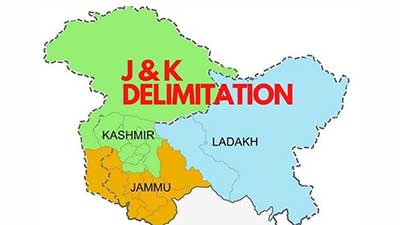Relevance: GS-2 : Parliament and State legislatures - structure, functioning, conduct of business, powers & privileges and issues arising out of these.
Key Phrases: Reorganisation Act, 2019,Delimitation Commission or Boundary Commission, pok, Scheduled Tribes (STs), geographical features, demographic status.
Why in News?
- After multiple objections and extensions, the J&K Delimitation Commission submitted its final report recently, two years after it was appointed to redraw the electoral boundaries in Jammu and Kashmir as per the mandate set by the Jammu & Kashmir Reorganisation Act, 2019.
What is Delimitation?
- Delimitation is the process of redrawing boundaries of the Lok Sabha or Assembly constituencies, the Election Commission of India states.
- The process is carried out in accordance with changes in the demographic status of a State or Union Territory.
- Delimitation is done by a Delimitation Commission or Boundary Commission. The orders of the independent body cannot be questioned before any court.
- In the past, Delimitation Commissions were set up in 1952, 1963, 1973, and 2002.
- Before the abrogation of Article 370 that accorded a special status to J&K, delimitation of its Assembly seats was carried out by the Jammu and Kashmir Constitution and the Jammu and Kashmir Representation of the People Act, 1957.
- The delimitation of Lok Sabha constituencies, meanwhile, was governed by the Constitution.
What is the J&K Delimitation Commission?
- The last time a delimitation exercise was carried out in Jammu and Kashmir was in 1995, based on the 1981 Census.
- Jammu and Kashmir was under President’s rule at that time. There was no Census in 1991 in J&K due to the tense situation in the valley.
- In 2001, the Jammu and Kashmir Assembly passed a law to put the delimitation process on hold till 2026.
- The Centre set up a Delimitation Commission in March 2020, six months after the State of Jammu and Kashmir was bifurcated and reorganised as the Union Territories of Jammu and Kashmir and Ladakh.
- The Commission, headed by retired Supreme Court judge Ranjana Prakash Desai, was tasked with delimiting the Assembly and Lok Sabha constituencies in the UT of J&K based on the 2011 Census and in accordance with the provisions of the Jammu and Kashmir Reorganisation Act, 2019 and the Delimitation Act, 2002.
- The panel was given a year to complete the delimitation plan but was given two extensions.
- After considering submissions and considering factors like “geographical features, communication means, public convenience and contiguity of areas”, the Delimitation Commission released its final report recently.
Key Takeaways From The Final Report
- J&K is split into two divisions:
- J&K is split into two divisions, with Jammu having 37 Assembly seats and Kashmir 46.
- After the Commission's final draft, six additional Assembly seats are earmarked for Jammu (revised to 43) and one for Kashmir (revised to 47). The total number of Assembly seats in the UT will increase from 83 to 90.
- Nominate at least two Kashmiri Pandits:
- The Commission has recommended the Centre to nominate at least two Kashmiri Pandits to the Legislative Assembly.
- Nine seats for the Scheduled Tribes (STs):
- The panel has proposed nine seats for the Scheduled Tribes (STs). These will include six in Jammu (Budhal, Gulabgarh, Surankote, Rajouri, Mendhar, Thanamandi) and three in the valley (Gurez, Kangan, Kokernag). Seven seats have been reserved for the Scheduled Castes (SCs) in the Jammu region.
- Representation to displaced persons from POK:
- The Commission has also recommended that the government consider giving displaced persons from Pakistan-occupied Jammu and Kashmir representation in the Assembly through nomination.
- Jammu & Kashmir region as one single Union Territory:
- In its final order, the Commission has noted that it has considered the “Jammu & Kashmir region as one single Union Territory”, and merged Rajouri and Poonch (from Jammu division) with the Anantnag constituency in the Kashmir region. The new constituency has been renamed as Kishtwar-Rajouri.
- Renamed 13 constituencies considering public sentiment:
- The Commission has said it renamed 13 constituencies considering public sentiment in the region. The order shows that in Kashmir, the names of Gulmarg (from Tangmarg), Hazratbal, Zadibal, Lal Chowk, Eidgah have been restored. In the Jammu region, the name of the Gulabgarh constituency has been restored.
- Added seven more Assembly seats:
- The Commission has added seven more Assembly seats, keeping the 2011 census as the basis. With this, Jammu with a population of 53 lakh (43% of the total population of 122 crore) will have 47% seats, while Kashmir which has a population of 68 lakh (56%) will have 52% of the seats.
Conclusion
- The final order of the Delimitation Commission for Jammu and Kashmir holds a lot of political significance. The completion of the delimitation exercise will pave the way for Assembly elections - a crucial step in the possible restoration of statehood for Jammu and Kashmir.
Sources: The Hindu
Mains Question:
Q.What is delimitation? How will the redrawing of electoral boundaries affect the people of J&K? (250 Words).







